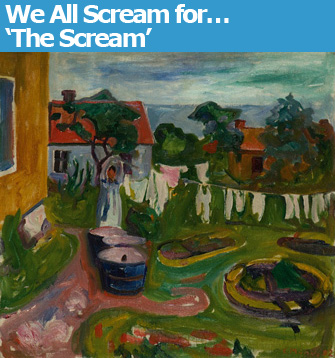 |
|
“Vêtements Etendus à Åsgårdstrand” (1902). Photo © Thomas Widerberg © The Munch-Museum/The Munch-Ellingsen Group/Adagp, Paris 2010 |
Exhibitions at the Pinacothèque de Paris often approach a subject from an oblique angle, and “Munch, ou L’‘Anti-Cri’” (“Munch or the Anti-‘Scream’”) is no exception. As the title indicates, you …
 |
|
“Vêtements Etendus à Åsgårdstrand” (1902). Photo © Thomas Widerberg © The Munch-Museum/The Munch-Ellingsen Group/Adagp, Paris 2010 |
Exhibitions at the Pinacothèque de Paris often approach a subject from an oblique angle, and “Munch, ou L’Anti-‘Cri’” (“Munch, or the ‘Anti-‘Scream’”) is no exception. As the title indicates, you won’t see any of the versions of the painter’s iconic “The Scream” in this show.
The show’s title made me realize that I, too, was familiar with little more of the work of Edvard Munch (1863-1944) than “The Scream,” certainly an injustice to Norway’s artistic pride and joy, so I was pleased to have the opportunity to see what else he had produced in his long career.
The Pinacothèque has the particularity of placing great emphasis on an artist’s biography and psychology – always interesting but not always essential to appreciating the work. In the case of Munch, the biography does seem relevant, since it had such a strong influence on his artistic obsessions: he lost his mother and sister to tuberculosis at a young age (images of sickly little girls appear over and over again in his paintings and works on paper) and was brought up in poverty by an extremely pious father.
The show starts with some almost too-pretty early landscapes, but soon moves on as the amazingly versatile Munch found his own iconoclastic way, rejecting the artistic flavor of the day, whether it was Impressionism, Symbolism or Naturalism – another reason the “anti” of the show’s title is so apt. He liked to mix techniques and scratch and scrape the surface of his paintings, and was even known to intentionally leave paintings out in the rain and snow to see what the effect would be.
The prettiness of the early landscapes sometimes reappears, but almost always with a touch of menace or darkness. In the lovely “Woman with a Red Hat on the Fjord” (1891), for example, the woman’s blue dress is almost the same pretty color as the water behind her, but the bright red of her contrasting hat turns to the color of dried blood in the shadows on the green grass she stands on.
Munch’s anguish – so vividly represented in “The Scream” – comes through more subtly in other works, many of which exude a feeling of loss, loneliness and alienation. Some of his favorite themes include love triangles, jealousy and melancholy. Men in his pictures are bewitched by women with long, sumptuous manes of hair. In some of the later works presented here, figures sometimes seem to dissolve, as in the watercolor “Visitors to Ekely” (c. 1938).
The Pinacothèque announces at the beginning of the show that all the works included come from private collections, which in theory means that the public rarely, if ever, gets a chance to see them, but it turns out that many of these pictures belong to art dealers, which makes you wonder if they are there to raise their market value. One might also wonder why the Pinacothèque didn’t obtain loans of Munch’s masterpieces from museums, the usual procedure for such an exhibition. The Pinacothèque’s owner, art historian Marc Restellini, claims that the jealous Parisian art establishment worked behind the scenes to prevent loans from the major museums.
Which brings us to the politics of the French art world. The Pinacothèque – like the now-closed Musée du Luxembourg (which will eventually reopen under new management) and the Musée Maillol since the recent death of its founder, Dina Vierny – is sharply criticized by the French press for its “commercialism” (the curators of the Pinacothèque and the Maillol are both alumni of the Luxembourg). It seems to me, however, that there is a place for these galleries in Paris alongside the government-supported museums. The Musée de Luxembourg’s shows improved in quality over the years and brought many fine artworks to Paris, and, while the Pinacothèque’s exhibitions are far from perfect – the show on Jackson Pollock contained hardly any paintings by him, for example – it takes an admirably passionate approach to its subjects and has put on some fine shows, among them “Chaïm Soutine” in 2007-08.
The show on Munch may offer a slightly skewed vision of the painter, but it is well put together and has the merit of bringing the neglected work of this artist to France, where he has been pretty much ignored, and may inspire visitors like me who were unfamiliar with non-“Scream” Munch to go to the Munch Museum and National Gallery in Oslo to see the major works that are the missing links in this show.
Pinacothèque de Paris: 28, place de la Madeleine, 75008 Paris. Métro: Madeleine. Tel.: 01 42 68 02 01. Open daily 10:30 a.m.-6 p.m. (until 9 p.m. on Wednesday; 2 p.m.-6 p.m. on May 1 and July 14). Admission: €10. Through August 8. www.pinacotheque.com
Buy related books and films from the Paris Update store.
More reviews of Paris art shows.
Reader Reaction: Click here to respond to this article (your response may be published on this page and is subject to editing).
© 2010 Paris Update
Favorite